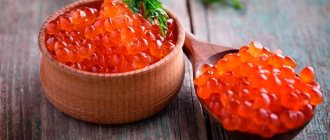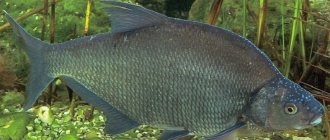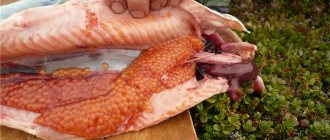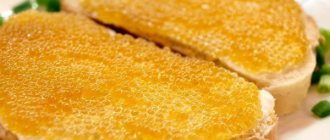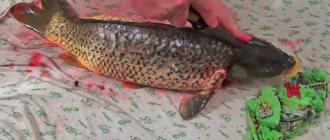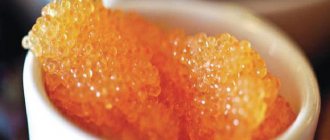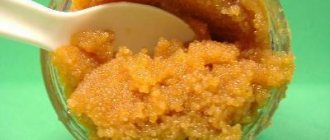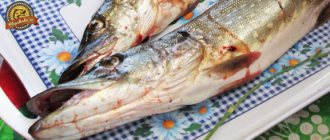How to salt river fish caviar at home
Every true fisherman must be able to not only catch fish, dry it and dry it, but also salt the caviar himself . After all, properly salted fish roe is a real delicacy .
In addition, homemade caviar is very healthy due to its naturalness and high nutrient content. In this article we will talk about the technology for salting fish roe at home and provide several detailed recipes that will help you prepare an amazingly tasty appetizer.
How to properly remove caviar from fish
You can use caviar for salting only if the fish is fresh enough. To remove the caviar, you need to act very carefully and accurately. First we cut the belly of the fish. Then, with our fingers, we pick up the elongated shell bags with caviar and slowly separate them from the cavity of the fish.
It is very important to remove the caviar in one piece, since if handled carelessly, bitter bile . Oysters are separate egg parts covered with a thin film, the internal filling of which plays a binding role for the eggs.
How to legally catch fish with red caviar in Kamchatka during the spawning period
Otherwise, the fine is 10,365 rubles for each tail...
But there are options so as not to pay a fine, and to enjoy the fight with chum salmon or coho salmon, eventually catching fish with caviar. Well, and then to make delicious red caviar yourself, as I described in detail here.
When I published a photo of a caught chum salmon on my Instagram, my subscribers literally hated me: they say, I’m a poacher. Meanwhile, they were mistaken: I am a public person and would not risk such things. Therefore, before realizing my long-standing desire - to catch salmon with caviar and make caviar myself, I learned about legal ways to realize it.
Fishing inspector's trailer on the Paratunka River, where you can buy a fishing license
The main thing: you can catch salmon during the spawning period!
To do this, you simply don’t need to be greedy and... just buy a license.
Its cost in Kamchatka is only 500 rubles (you must agree, much less than the amount of the fine), it is issued for 1 day and under this license you can catch no more than 3 tails per amateur tackle during the spawning period.
Yes, even when purchasing a license, you need to indicate the specific type of fish for which you are buying it. In principle, there are no problems with this, because You can always ask other fishermen what is spawning now: chum salmon, coho salmon, pink salmon or sockeye salmon. Of course, there is a chance that the species of salmon that is not specified in the license will be caught. But... as an option, you can release the fish. And as an alternative option, run to the fish inspector and buy a license for this fish for the same 500 rubles for three tails.
I fished on the Paratunka River, along which chum salmon and coho salmon rise to spawn. The place here is beautiful, overlooking the volcanoes, and on the day I came to fish, there were a lot of fishermen standing on the shore.
I waited for my first chum salmon for more than an hour, unsuccessfully casting a spinning rod either with a Tasmanian devil or with a spinner as bait. More precisely, it is not entirely correct to call spoons lures when fishing for salmon during spawning, because the fish rushes at them not because they are hunting.
She rushes, as if repelling an attack on herself, when you move the bait against the current along which chum salmon or coho salmon rise to the spawning site. The fish perceives it exclusively as a danger, and not as food. Because in rivers during spawning, salmon completely stop feeding.
I didn't catch anything else that evening without fully exercising the license.
But, to be honest, I wasn’t the least bit upset about this, because... firstly, I had a lot of fun fishing for 2.5 kilogram chum salmon. And secondly, she turned out to be a female, full of excellent ripe eggs, from which in the evening I prepared a whole bowl of excellent red caviar.
It was after this fishing that I published a detailed photo recipe on how to properly make red caviar. If anyone is interested, you can read it here.
——
Like if you like fishing, share with friends and
subscribe to my channel so as not to miss the next stories from your trip to Kamchatka, as well as follow new publications from my travels.
You can follow my travels online in the stories of my Instagram account
@travelmaniac_ru.
Preparing caviar for salting
Caviar from pike, roach, perch, carp, rudd, bream and crucian carp is ideal for salting. To prepare the appetizer we will need at least 150 grams of caviar .
The main preparatory stage is the release of the eggs from the film . This procedure is called "punching". Since we are working with a small amount of caviar, for these purposes you can use a colander, a sieve or a vegetable grater with non-sharp hole edges.
The larger the eggs, the larger the holes in the dish should be so that the eggs can pass through them freely. But the process of caviar cleansing is much faster if we use a colander.
Artificial caviar
Artificial caviar of different salmon differs greatly in size and color shades. The diameter of the eggs of pink salmon, sockeye salmon, coho salmon and masu salmon is 3-4 mm, and the diameter of the eggs of chum salmon and chinook salmon is 5-7 mm. Chum salmon caviar is orange with a red glow; pink salmon caviar of orange and light orange color; Sockeye salmon caviar is dark red, even a little burgundy. The variety of sizes and colors of artificial salmon caviar will allow you to successfully catch the main commercial Pacific fish: chum salmon, pink salmon, masu salmon, sockeye salmon, coho salmon and chinook salmon, as well as whitefish of its varieties: pyzhyan, muksun, vendace, peled, whitefish (schokura), tugun, valaamka , migratory and lake whitefish and others.
Recipes for salting caviar - preface
The simplest recipe for salting caviar, known to all fishermen, is to place the caviar in a bowl, add salt, stir and let it sit for a while. After this, the caviar is considered ready for consumption. But do not forget that freshwater fish can be infected with various parasites, which will happily settle in the human body. And there are especially many of these parasites in fish caviar!
Therefore, eating caviar salted according to this recipe is very risky for health. Another disadvantage of this cooking method is the smell of fresh fish in the appetizer . To avoid all this, it is necessary to follow a special technology when salting, which will not only protect you from parasites, but also make the caviar very tasty.
Lucky John Trout Roe
Date: January 27, 2021 | 452
The Salmo company and their Lucky John brand have significantly expanded their range of soft baits and edibles. The lines of not only jig classics have expanded, but also various other directions. Thus, a series of imitation baits was created, which in silicone recreate the usual food of fish, and, in combination, popular baits. the Lucky John Trout Roe bait appeared . This is artificial red caviar, salmon caviar. The bait is unusual, non-standard. Let's look at it and its application in more detail.
“Trout Roe” translates as “trout caviar”, “salmon caviar”. Those. This is the caviar of any salmon fish, red caviar, in fact. So, be careful, don’t mix it up and don’t eat it.
It is well known that in spawning rivers, where salmon fish rise from the sea to spawn, the permanent inhabitants are very fond of caviar. Various sedentary forms of trout, lenka, etc., rush after schools of spawning salmon to feast on eggs. It is to protect against these “vultures” that male salmon fish grow a beak, with which they literally cut their opponents in half, so as not to encroach on the eggs. Another result of this natural mechanism is that people, fishermen, often successfully catch fish using eggs. And this is true not only in such spawning reservoirs.
The fish has a good lip - it loves red caviar.
Form . The shape of Lucky John Trout Roe is appropriate, round, like real salmon eggs. The balls are not ideally shaped, which makes the bait even more similar to real caviar and makes it more convenient to work with them when placing them on hooks.
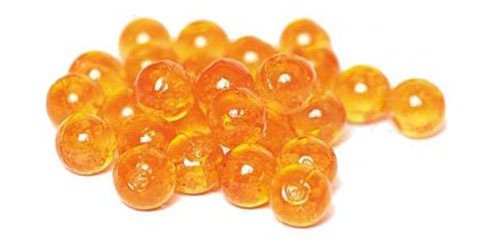
What does it imitate ? Large red caviar.
Active or passive . Naturally, Lucky John Trout Roe is a passive bait, an artificial bait, or even, rather, an additional attachment to a hook or spoon or jig.
Dimensions . Artificial caviar is produced in two sizes: 4.5mm and 6mm in diameter.
Package . Lucky John Trout Roe silicone is sold in plastic jars. Inside, artificial eggs lie in bulk, generously coating each other with an attracting lubricant.
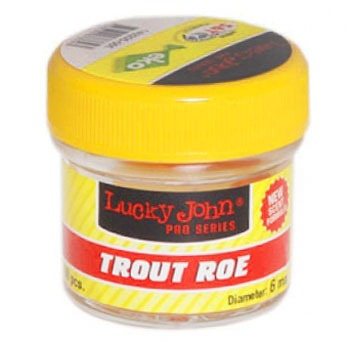
Lucky John Trout Roe size 4.5mm comes with 70 eggs per jar, and size 6mm comes with 60 eggs per jar.
Price . A jar of Lucky John Trout Roe costs about $4. As for such a considerable number of baits - a very humane price tag.
Material . Lucky John Trout Roe eggs are made from moderately soft silicone. So, such eggs stay great on the hook. Fish rarely pick them off. And in order to ruin such a bait, the fish need to tear it into trash, which is not easy.
Silicone is impregnated with an attractant. Smells like fish and seafood.
Colors . Orange color. Very natural, like real caviar. Since caviar of different maturity and different breeds of salmon may have a different hue, this is a normal average option.
How to mount . Lucky John's Trout Roe Silicone Caviar can be used as a primary or secondary bait (in combination with some live bait). You can fish with this edible fish with a regular float fishing rod, with a donka, with a winter fishing rod, in winter, respectively. Also, the eggs can be placed on the hook of a spinner, jig, or used as an attachment in a nanojig.

Purpose . Since salmon eggs are readily eaten by any fish, the Lucky John Trout Roe bait is widely used.
Wiring . The shape of the ball does not imply any abstruse animations. You can simply fish with the current, you can twitch, add minimal vibration, or even fish with a stationary bait.
Advantages . High similarity to natural food that is very popular among fish. Softness, edibility. Normal price.
Conclusions . Lucky John Trout Roe is an unexpected solution for anglers engaged in peaceful fishing, rod fishing, donkey fishing, and winter fishing. You don’t have to bother with live bait, but try fishing with Lucky John Trout Roe caviar, or with other baits in this series: Lucky John Extra Blood Worm, or Lucky John Maggot maggots. Also, this caviar can be used for nanojig. Not a bad material and a field for experimentation.
Share with your friends:
Categories: Lucky John · Tags: Lucky John, Caviar, Bait, Edible
Recipe No. 1
First we need to prepare the brine. Rapa is a special salt solution for washing fish eggs.
- The proportions of standard brine are 100 g of salt per 1 liter of water. Bring the solution to a boil and pour the caviar into it while hot.
- Stir the caviar with a fork for about 3 minutes so that the hot solution covers all the eggs. Then we drain the brine and prepare a new one to repeat the procedure.
- A total of 3 fills are required. The first two times the water turns out cloudy, but the third time it should be more transparent and clean.
Recipe No. 2
To salt caviar according to this recipe we will need an enamel pan . Pour water into it - the volume is approximately three times greater than the volume of existing caviar. Add salt to the water (as for boiling eggs) and bring the saline solution to a boil. Add various spices and herbs to boiling water to taste: bay leaf, ground black pepper, black peppercorns.
Then remove the water from the heat and pour the prepared caviar into it. Cover the pan tightly with a lid and leave to steep for 15 minutes, no more. Strain the caviar through cheesecloth, allowing the water to drain completely. After the caviar has cooled, it is ready to eat. Storage in the refrigerator at a temperature of 0 -5 C is possible for a month .
Recipe No. 3
This method of salting caviar is significantly different from others. This kind of caviar is usually called “ pressed caviar ”. For salting, caviar is stored in presses, that is, in the bags in which it was originally located. Even torn and damaged bags will do. You can also salt a mixture of caviar from different river fish in one bowl.
Salting is done by placing the caviar in a bowl in layers and covering them with a large amount of salt. Each layer must be separated by a spacer made of hard material. After salting, the caviar is washed and dried. The result should be oblong rectangles of a dark color. Even if this is the first time we see a recipe for making pressed caviar, we are already familiar with it and have tried it more than once . After all, such caviar can be in any dried fish.
Proper preparation of crucian caviar for salting
The caviar of many river representatives is perfect for salting. In the case of crucian carp, less than 150 grams of fresh caviar should not be salted.
The following equipment is required for cooking:
- metal sieve;
- double piece of gauze 50x50 cm;
- medium sized bowl;
- three-liter saucepan.
The main operation during preparation is the extraction of eggs from the film elements. The larger the diameter of the eggs, the larger the holes in the dish should be so that individual eggs can pass freely without damage. Aluminum colander models should not be used. The product is distinguished by sharp edges of the holes, which spoils fish eggs. An enamel colander is ideal. Rasporov payus (hymen that protects the eggs), fill the dishes and slowly wipe the product by hand, with the back of your hand. If the cell is large enough for a single egg, it is allowed to use a stainless steel sieve.
When preparing a large amount of caviar, from two to three kilograms or more, you can use another cleaning method. In this case, the caviar is placed on a cutting board and squeezed out with the back of a knife blade.
In everyday life, special means are also used for cleaning fish eggs - screens. The device is a rectangular mesh. Having placed the eggs on the surface of the device, they are stroked by hand, and the separated eggs fall onto a previously placed basin or pan.
In another case, a “stirrer” is used, which is set in motion along the axis by hand. The waste in the form of films is wound around various parts of the rotary tool. However, this method is generally suitable for large quantities of product.
We recommend reading: Features of preparing pearl barley for catching carp fish
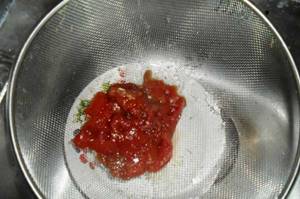
Terpug in the oven
The dish turned out unexpectedly. Initially I was going to bake the fish in the sleeve. But along the way I changed my mind. I am sharing a delicious recipe with the readers of nepolneem.ru There was a whole, not gutted greenling - a medium-sized white fish. The meat vaguely resembles mackerel. I wanted to stuff sprigs of parsley and green onions into the belly. Sprinkle with lemon and put it in your sleeve. But the greenling turned out to be caviar, and I immediately imagined a white sauce with grains of caviar and the taste of black pepper. I also decided to add squid.
